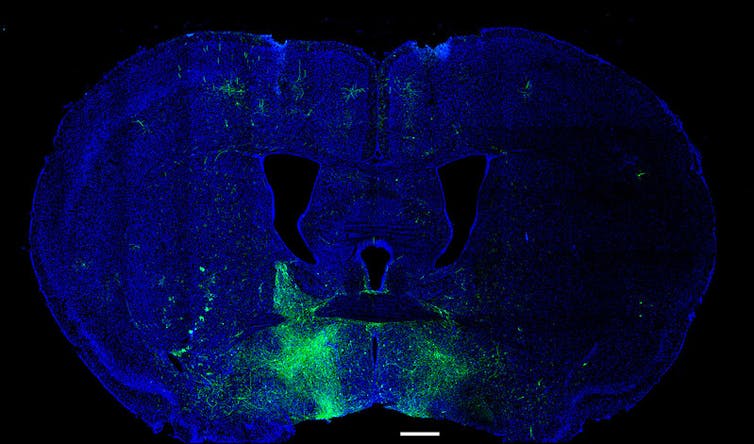
Madugrero/Wikimedia Commons, CC BY-SA
Bill Sullivan, Indiana University
Insects do a lot more harm than ruining picnics. Some insects spread devastating diseases, while others cause staggering economic losses in agriculture. To control some of these pests, scientists are developing males that make sex a deadly event.
The stakes are high. Mosquitoes carry viruses such as dengue, West Nile and Zika, as well as parasites that cause malaria. Researchers estimate that mosquitoes have caused the deaths of 52 billion people overall – nearly half of all the humans that have ever lived.
Other insects cause major crop damage, jeopardizing the food supply and driving up prices. According to the Food and Agriculture Organization of the United Nations, 20% to 40% of global crop production is lost to pests annually at a cost of US$70 billion.
Pesticides have been the front-line defense against insects, but many bugs have evolved resistance to these chemicals. Some pesticides can indiscriminately kill beneficial insects, harm the environment and endanger human and animal health. Some researchers worry that certain pesticides can cause cancer or have damaging effects on human nervous and endocrine systems.
I’m a microbiology researcher studying infectious disease. New solutions that do not harm humans and the environment to control disease-carrying insects and agricultural pests could lead to fewer people contracting dangerous diseases. In the past few years, a variety of genetic engineering approaches have emerged as promising tactics to combat problematic insects.
Genetically modified insects
To avoid the problems associated with pesticides, scientists have devised new approaches that genetically alter the insects themselves in ways that cause their population to crash or render them incapable of transmitting disease – a strategy called genetic biocontrol.

The idea to suppress an insect population by flooding it with sterile males has been around for decades. Since the 1950s, scientists have been using radiation to create infertile male mosquitoes. These sterile males mate with females but produce no offspring. Since females are engaged in a lot of unproductive mating, the overall population tends to decline.
In the past two decades, genetic engineering has been used to introduce dominant lethal genes into insect populations. In this approach, the offspring of genetically modified males inherit a gene that kills them before they reach reproductive age. A field trial in Brazil found that this strategy reduced the target mosquito population up to 95%. Another approach on the horizon involves releasing insects genetically modified to be poor carriers of pathogens that cause disease.
Despite these advances, a key shortcoming to current genetic biocontrol methods is that they take time. At least one generation needs to be born before the population suppression begins. This means the female insects continue to be a disease vector or agricultural pest until they die a natural death. An ideal technique would neutralize the females immediately, especially during outbreaks.
A faster approach
Biologists Samuel Beach and Maciej Maselko at Macquarie University in Australia sought to solve this dilemma by genetically engineering male insects to make poisonous semen. The poisonous semen would kill the female quickly, reducing the population faster than previous biocontrol methods.
To test this idea, the team used fruit flies called Drosophila melanogaster, which are easy to genetically modify and study in the lab.

Rodrigo Tetsuo Argenton/Wikimedia Commons, CC BY-SA
The researchers transferred venom genes from the Brazilian wandering spider (Phoneutria nigriventer) and the Mediterranean snakelocks sea anemone (Anemonia sulcata) into the genomes of fruit flies.
The genetically modified fly produces and stores venom proteins in its male accessory gland – a fly’s prostate – along with other seminal fluid proteins. Upon mating, the fly deposits the venomous semen into the female’s reproductive tract. The researchers named this approach the toxic male technique.

Diego Delso
After mating, the seminal toxins seep into the female’s body and attack her central nervous system. The toxins bind to proteins called ion channels on cellular membranes, which nerve cells use to communicate with one another. This quickly leads to paralysis and respiratory arrest. You could say these genetically engineered Romeos literally take her breath away.
The lifespan of female flies that mated with toxic males decreased – up to 64%. A computer simulation of the toxic male technique for Aedes aegypti, a mosquito that transmits several viruses, predicted that this approach could work better than current methods.
Safety and effectiveness
While promising and innovative, there are some important challenges that researchers developing the toxic male technique will need to overcome. For example, the technique has been shown to work only in fruit flies. Whether it will work in mosquitoes or other insect pests remains an open question.
In addition, the technique reduced the female lifespan by only 37% to 64%. To improve the rate of killing, the researchers suggested that other venom formulations might work better. Researchers could try thousands of venom genes from spiders, snakes, scorpions and centipedes. Each new venom they try will require tests to ensure the modified males tolerate them – if they become weak, unmodified males may outcompete them for mating opportunities.
As with all genetic biocontrol methods, this technique may be too expensive to implement for low-income countries. Nations would need to finance the costs of breeding and deploying the mosquitoes safely.
Insects also pollinate plants and serve as food sources for other animals, such as bats. If these insects vanish, the ecosystem could face unforeseen adverse effects. Monitoring these potential effects on the environment will also be expensive.
Other researchers are experimenting with using venom toxins to control parasites that female insects spread through biting. Called paratransgenesis, this technique alters an insect’s gut bacteria to produce a toxin that kills the parasite, leaving the insect unharmed. Since the insect population remains unaltered, paratransgenesis may pose less risk to ecosystems.
Insects tend to adapt quickly to the methods humans use to control them, so it is advantageous to have multiple strategies at our disposal. The toxic male technique may one day become a valuable new weapon in the arsenal to combat insect pests.![]()
Bill Sullivan, Professor of Microbiology and Immunology, Indiana University
This article is republished from The Conversation under a Creative Commons license. Read the original article.





























































